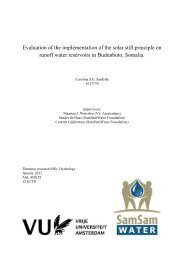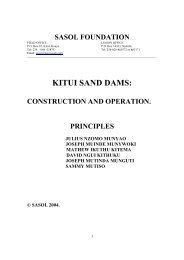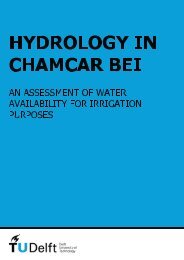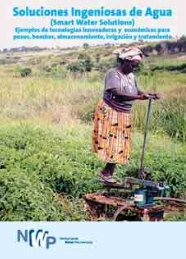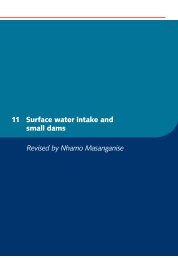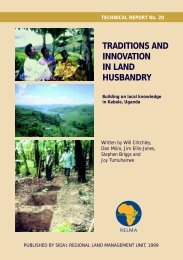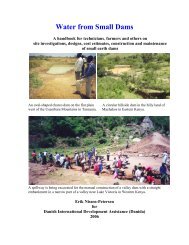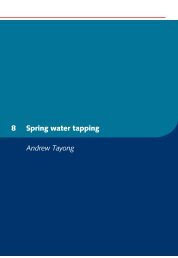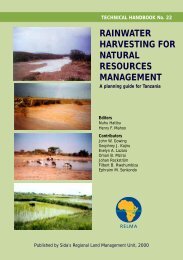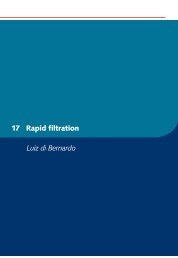Hydrogeology and siting of micro-dams around Léo Burkina Faso
Hydrogeology and siting of micro-dams around Léo ... - SamSamWater
Hydrogeology and siting of micro-dams around Léo ... - SamSamWater
Create successful ePaper yourself
Turn your PDF publications into a flip-book with our unique Google optimized e-Paper software.
<strong>Hydrogeology</strong> <strong>and</strong> <strong>siting</strong> <strong>of</strong> <strong>micro</strong>-<strong>dams</strong> <strong>around</strong> <strong>Léo</strong>, <strong>Burkina</strong> <strong>Faso</strong>14 June 20104.5 Water balance Sanga (<strong>micro</strong>-dam constructed in 2008-2009)Based on the few measurements done last year <strong>and</strong> the short visit this year it is hard to get acomplete underst<strong>and</strong>ing on the hydrology <strong>of</strong> the <strong>micro</strong>-<strong>dams</strong>. However, with all information gatheredit is possible to set up a basic water balance so it becomes clear which fluxes are most important inthe hydrology <strong>of</strong> <strong>around</strong> the <strong>micro</strong>-dam.Since the volume <strong>of</strong> the reservoir upstream <strong>of</strong> the dam is relatively small compared to the totalamount <strong>of</strong> discharge <strong>of</strong> the river, the reservoir will be filled quickly after the start <strong>of</strong> the rainy season<strong>and</strong> will remain completely full until the end <strong>of</strong> the rainy season.Once the rains have stopped the river will no longer flow <strong>and</strong> the reservoir will be filled up to the level<strong>of</strong> the spillway. Then, the level in the reservoir will start to decrease due to:- evaporation;- infiltration <strong>of</strong> water into the soil;- use <strong>of</strong> water by cattle (drinking);- use <strong>of</strong> water for other reasons (brick making, washing, gardening, etc.).In the case <strong>of</strong> Sanga, the water level at mid February was 1.34 m below the level <strong>of</strong> the spillway. Thelast rains had occurred at the end <strong>of</strong> October, so the drop in water level had occurred over a period <strong>of</strong>approximately 105 days.The decrease <strong>of</strong> the water level because <strong>of</strong> evaporation can be estimated based on historicalmeteorological data. The tool New_LocClim (FAO, 2005) produces a good estimation for the averagedaily evaporation. For the area <strong>around</strong> <strong>Léo</strong> the average total evaporation from the end <strong>of</strong> October tothe middle <strong>of</strong> February is 0.46 m. This means that 0.46 m <strong>of</strong> the total drop in water level is caused byevaporation.Infiltration is harder to estimate, since it largely depend on the soil. According to the experiencedlocal hydrogeologist Mr. Traore, the average infiltration <strong>around</strong> these types <strong>of</strong> soil is 2 to 5 mm/day.Over a period <strong>of</strong> 105 days infiltration causes a drop in water level <strong>of</strong> somewhere between 0.21 m(0.002 m/day x 105 days) <strong>and</strong> 0.53 m (0.005 m/day x 105 days).The drop in water level by cattle is mainly accounted for by cows. They are the largest in number inthe area <strong>and</strong> drink more than goats <strong>and</strong> sheep. According to CREDO a total number <strong>of</strong> 3000 cows usethe reservoir for drinking, although they don’t come to the Sanga reservoir every day. It is estimatedthat <strong>around</strong> 1000 cows come to drink at the reservoir every day. On average an African cow drinks 27liters water per day (Nissen-Petersen, 2006). The total amount <strong>of</strong> water that is used by cattle is:27 x 1000 = 27,000 = 27liter per cow cows liter m 3per day per day per dayTo calculate the effect on the water level this amount has to be divided by the surface area <strong>of</strong> thereservoir. The maximum surface area <strong>of</strong> the reservoir (when the reservoir is filled up to the spillway)is <strong>around</strong> 16,300 m 2 . In February the surface area <strong>of</strong> the water was reduced to <strong>around</strong> 3,000 m 2 . Sothe average surface area between October <strong>and</strong> February is <strong>around</strong> 9,700 m 2 . This is not completelyaccurate since in real the decrease in surface area will not be linear like it is assumed here, but thiscan be neglected.So between October <strong>and</strong> February 2,835 m 3 (27 m 3 /day * 105 days) <strong>of</strong> water is being extracted out <strong>of</strong>the reservoir with an average surface area <strong>of</strong> 9,700 m 2 . This has caused a drop in water level <strong>of</strong> 0.29 m(2,835 m 3 / 9,700 m 2 ).The decrease <strong>of</strong> water level for other sources like washing <strong>and</strong> brick making can be calculated in thesame way. Based on field observations the amount <strong>of</strong> water that is being extracted for brick making ismuch larger than the extractions for other sources (e.g. washing). Brick makers get water in 200 lbarrels which they fill at the reservoir <strong>and</strong> transport with a donkey-cart to the brick making site. It isestimated that on average 100 barrels are being filled per day. 100 barrels times 200 liter gives a totalextraction <strong>of</strong> 20,000 liter per day, which equals 20 m 3 per day. Divided by an average surface area <strong>of</strong>the reservoir <strong>of</strong> 9,700 m 2 , this causes a drop in water level <strong>of</strong> 0.22 m.20




